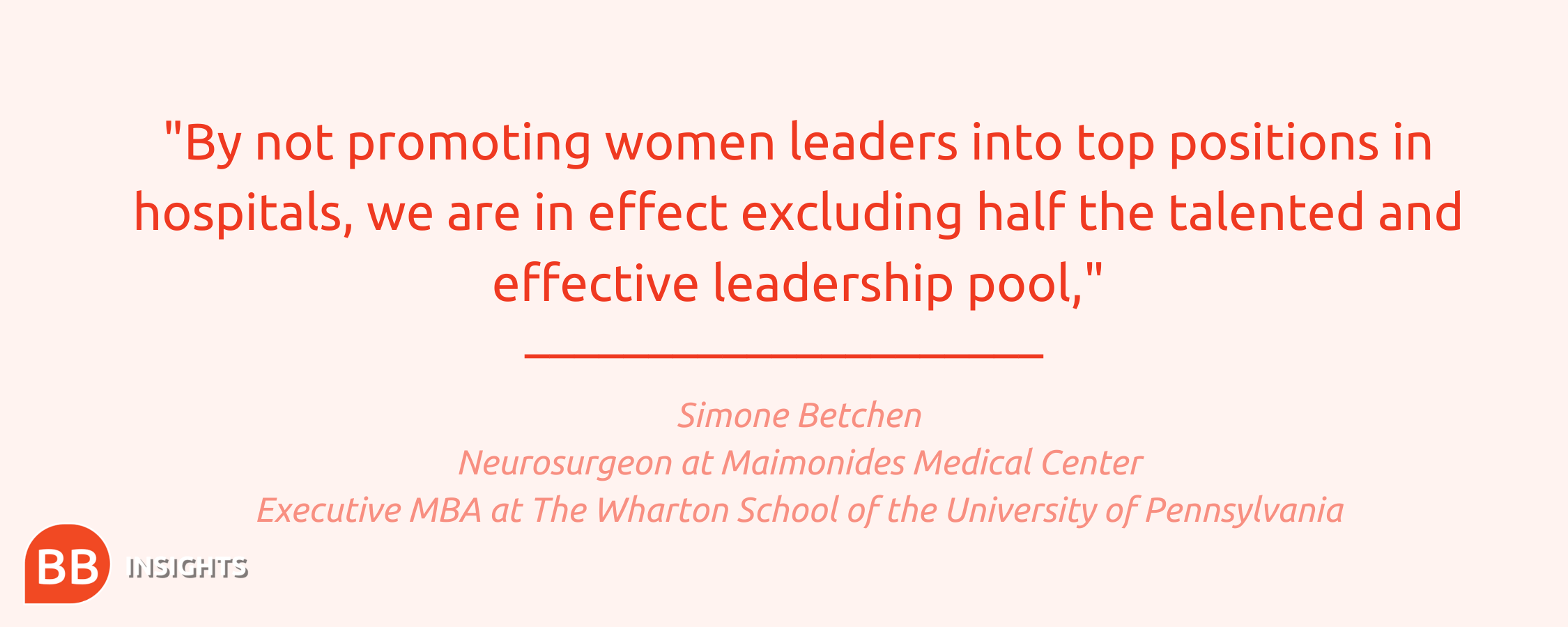Women comprise 70% of the globe’s healthcare staff, making the healthcare sector one of the few sectors that hires more women than men. Representation in the workforce, though, does not always equate to higher representation at the executive level; women only equate to 25% of senior leaders in healthcare.
Something’s going wrong with female leadership in healthcare. Despite seven in 10 women making up the global healthcare sector, it takes them three to five years longer to reach CEO positions, according to a recent Oliver Wyman study. The same study found that women make up only around 30% of C-suite executives and 13% of CEOs across the sector.
The barriers to leadership for women in healthcare
One of the sticking points for women reaching leadership roles is that they face difficulties building networks with predominantly male senior executives who can play a vital role in helping employees climb the leadership ranks. 
“Some of the challenges are just like they are across business: people are often more comfortable apprenticing, mentoring, and supporting people who are like themselves,” says Vivian Riefberg (pictured right), professor of practice at the University of Virginia Darden School of Business.
“One of the reasons it's taking longer for women to progress in healthcare is because women are getting stuck at every step. They're getting stuck at getting the first promotion, but they're also getting stuck in the organization’s pipeline itself,” she adds.
Like many professions, systemic issues like the gender pay gap and the disproportionate amount of time women spend on caregiving for their children lead to some women dropping out of leadership positions and, therefore, not progressing through the ranks at the same rate as men.
The issue is particularly acute for women of color, who are sorely underrepresented at the leadership level in healthcare, accounting for just 4% at the C-suite level in 2019, according to McKinsey.
Why we need to fix the female leadership problem in healthcare
The dearth of female leaders in healthcare is a problem, but matters of diversity, equity, and inclusion are just the tip of the iceberg. The issue can also come at the expense of financial stability and patient care.
Ingrid Nembhard (pictured right), associate professor of healthcare management at The Wharton School of the University of Pennsylvania, and her co-researcher, Simone Betchen (pictured below), a neurosurgeon at Maimonides Medical Center and Executive MBA student at Wharton, have been researching female leadership in healthcare.
In their study of more than 400 US hospitals, they found two areas where female CEO-led hospitals performed better than their male CEO-led counterparts. The two areas were the number of days in accounts receivable—the number of days before an invoice is cleared—and the number of patient deaths after a serious complication.
On over 20 other measures of financial and care performance that Ingrid and Simone examined, they found no difference between hospitals with female versus male leaders. In other words, female-led hospitals performed just as well as male-led hospitals.
“By not promoting women leaders into to p positions in hospitals, we are in effect excluding half the talented and effective leadership pool,” notes Simone (pictured below, right).
p positions in hospitals, we are in effect excluding half the talented and effective leadership pool,” notes Simone (pictured below, right).
Moreover, diverse leadership teams have been shown to foster innovation, which is crucial during crises like the global COVID-19 pandemic.
“Looking at the matter as a team is key to really understanding the role that women play in the C-suite, and how they can impact and help diversify the team, which we know from research allows for better decisions and business strategy,” Simone says.
How to form more equitable healthcare leadership teams
Healthcare institutions have a lot of work to do to improve gender parity at the senior leadership level, particularly within the C-suite. However, there are several things that they can do to create more equitable leadership teams.
Firstly, diversity and inclusion training. This training should emphasize how assumptions about what a traditional leader looks and behaves like often harm women’s chances of progressing, boxing females into the category of employee rather than leader.
The selection and interview process should also be reviewed. “Employers should be very intentional about what skills are needed for the role, and consider providing structured interview approaches versus unstructured ones, as the latter approach tends to reinforce bias,” comments Brad Staats (pictured below), professor of operations at the University of North Carolina Kenan-Flagler Business School. 
A Harvard Business Review article suggests that structured interviews minimize the risk of subjective opinions. Since women already face unconscious biases related to their gender, employers must engage in an interview process that solely assesses a candidate’s performance.
Secondly, healthcare institutions need to focus on supporting talented women in the workforce by encouraging women to participate in sponsorship and mentoring schemes, which can help them with self-promotion and performing well at the interview stage.
“Making people responsible for the success of others, not just the success of themselves, seems an important step,” says Ingrid from Wharton.
Healthcare institutions should also ensure there are enough female mentors and sponsors—in addition to male ones—offering a more diverse mix of people who women can go to for advice.
As these institutions begin to recover from the COVID-19 pandemic, there’s a chance to take a step back and fix healthcare’s female leadership problem. This opportunity must be grasped.
“If we believe this can be a turning point, there has to be much more celebration and recognition of the women who’ve made the difference,” concludes Vivian from Darden.
Read Next: How Working From Home Is Impacting Women
BB Insights explores the latest research and trends from the business school classroom, drawing on the expertise of world-leading professors to inspire and inform current and future leaders





